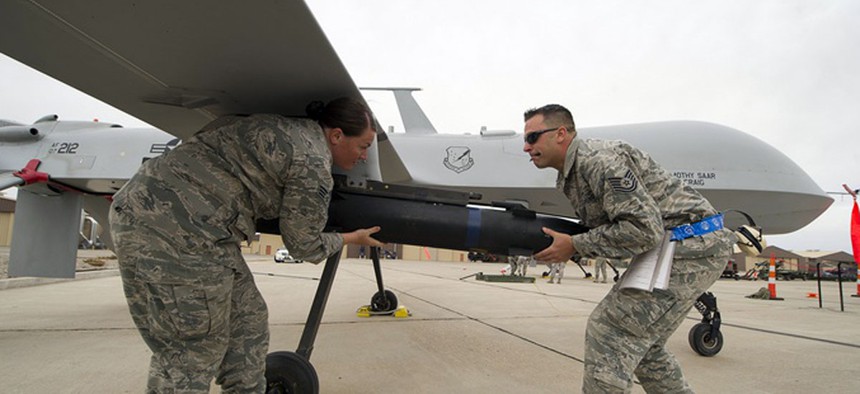The Air Force Wants You To Build Its Next Drone Engine

Two Air Force NCOs load munitions on an MQ-9 Predator. US Air Force
The Pentagon hopes the next Predator is in someone's garage.
Love aerial robots with Hellfire missiles? Here’s your chance to express that devotion. The Air Force on Tuesday announced a $2 million prize for the U.S. citizen who can design the best new engine. It’s the largest prize ever from a military service, according to Air Force Lt. Col. Aaron Tucker.
Here’s what the Air Force is looking for. “A successful 100-horsepower turboshaft engine [that] must operate on Jet A fuel, demonstrate a brake-specific fuel consumption less than or equal to 0.55 pounds of fuel per horsepower per hour, and generate at least 2.0 horsepower per pound,” Tucker told drone designers Tuesday at the Association for Unmanned Vehicle Systems International conference in Atlanta, Georgia. The overall goal: create a power plant with the fuel efficiency of a piston engine and the low weight of a turbine engine.
A 100-horsepower engine may sound like a small deal, and in a way it is, but that doesn’t mean it’s insignificant. It’s about the same output as the 115-hp engine that drives the General Atomics MQ-1 Predator drone.
Tucker told his audience that there’s currently no destination platform for the engine. Instead, it’s an attempt to spur innovation in the weight and horsepower class occupied by the Predator, the most significant unmanned military platform that the world has ever seen.
“What we’re seeing is a lot of activity down here [for small UAVs], a lot of systems that are in production up here [for large drones like the MQ-9 Reaper and Global Hawk], and this seems to be a place where we can stand to get some technology investment.”
The Predator first flew in 1994 as a spy drone. It wasn’t until 2004, when the Air Force armed it with Hellfire missiles during Operation Enduring Freedom in Afghanistan, that Predator became synonymous with the U.S. drone war and all the policy problems that have flowed from it. Long since surpassed in sophistication and capability—the MQ-1 has a range of 460 miles and endurance of 24 hours—it has nonetheless racked up more than two million hours of flight time.
The Pentagon began phasing out the Predator years ago in favor of the MQ-9 Reaper, which sports a 950-horsepower engine, a far larger payload, better electronics, and twice the speed and operating ceiling. But if the Predator has lost popularity in Washington, it’s gaining fans in militaries around the world. The Italian Air Force flies an unarmed reconnaissance version. Even the Chinese have built their own more-capable knock-off, the Cai Hong, or CS 4; it has a 2,100-mile range, almost fivefold the Predator’s.
And even if the Pentagon is retiring the MQ-1, the need for drones of its size isn’t going away.
“We’re not expecting too much change in the mission,” Tucker said. “We see there’s a need for increasing the fuel efficiency for that size-class engine.”
If the Air Force Prize succeeds, it could lead to UAVs that resemble the Predator but that can fly farther, carry more weapons, act like a tiny Global Hawk, or some combination of all of the above.
The announcement presents a novel workaround to the traditional acquisition process, a focus point for Air Force Secretary Deborah Lee James.
“If we can align air force and commercial markets, this is how we bend the cost curve,” said Tucker. But it also suggests that the Air Force is looking to develop a new UAV, distinct from—but not dissimilar to—the one that defined how drones are used in war.






